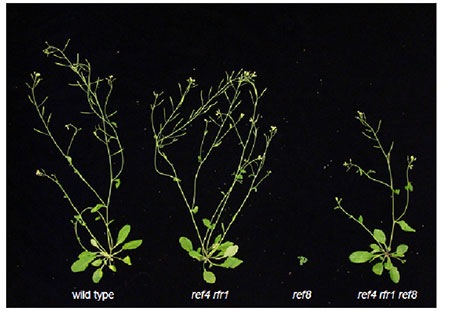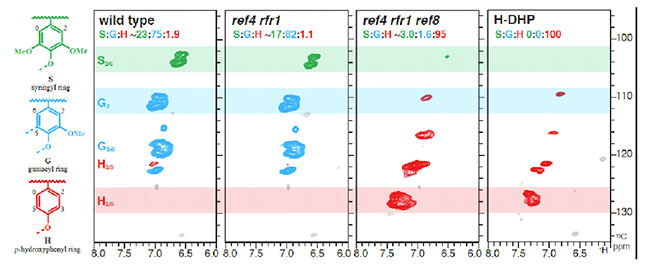Start Date: September 2013
PDF version
Investigators
Clint Chapple, Department of Biochemistry, Purdue University; Wout Boerjan, VIB Department of Plant Systems Biology, UGent Department of Plant Biotechnology and Bioinformatics; Claire Halpin and Gordon Simpson, University of Dundee; John Ralph, University of Wisconsin; and Xu ‘Sirius’ Li, North Carolina State University
Objective
The inability to process lignin, a cement-like component of secondary cell walls in plants, has been a major hurdle in the efficient production of low-cost biofuels from switchgrass, poplar and other cellulosic plants. This project aims to maximize the utility of plant lignocellulosic biomass as an abundant, sustainable and carbon-neutral energy feedstock by optimizing both its yield and composition to facilitate downstream conversions to fuel and electricity.
Background
Lignin in biomass crops interferes with the access of hydrolytic enzymes to polysaccharide components in the cell wall, inhibiting their conversion to fermentable monosaccharides, even after pretreatment. Gaining access to these sugars requires removing the lignin cement that holds the cellulose in place via an energy-intensive pretreatment process. Scientists have developed several varieties of plants with modified or reduced ligin – including tobacco, poplar, alfalfa and Arabidopsis – that exhibit increased cell wall degradability. However, some of these species also exhibit reduced growth and decreased biomass, or lignin-modification-induced dwarfism (LMID), which makes them unsuitable as commercial crops.1,2,3 LMID had been an insurmountable barrier to the optimal exploitation of cellulosic plants, but the GCEP research team recently discovered that LMID can be prevented in some Arabidopsis mutants, broadening the scope of lignin manipulation strategies that can be implemented. For example, the researchers found that altering genes CCR and C4H enabled up to 88% of sugars in the cellulose to be released, a three-to four-fold improvement over non-mutant plants. Part of this improvement is due to the ease with which lignin can be removed or depolymerized such that the cell wall literally falls apart after acid pretreatment. Unfortunately, these manipulations carry with them a yield penalty, an obstacle the team hopes to avoid by gaining control of LMID.

Approach
This work will tackle an unexplored domain within the realm of lignin management. The experimental materials, access to metabolites, proteins and transcriptional mechanisms will enable the dissection and control of the biochemical mechanisms that underpin LMID in reduced- lignin, CCR-, C4H- or C3H-deficient plants. Understanding the molecular mechanism(s) whereby suppressor mutations can restore the biomass yield of reduced-lignin plants (Figure 2) is of crucial importance, as it will reveal the basic principles whereby plants partition carbon to lignin and other metabolic compartments. Tools such as two-dimensional NMR (Figure 3) will be applied to investigate the metabolic changes in CCR-, C4H- or C3H-deficient plants and in the corresponding suppressor mutants with restored growth. The first objective will be to determine what proteins are required for LMID and thereby the mechanism(s) by which LMID comes about.

Figure 2: (Left) Developmental phenotype of the c3h (ref8) mutant of Arabidopsis exhibiting LMID, and c3h (ref8) suppressor mutants exhibiting restored growth.

Figure 3: (Bottom) NMR analysis reveals that the ref4 rfr1 ref8 mutant deposits a different type of lignin (with hydroxyphenyl) than wild type plants (syringyl and guaiacyl).
These advances will ensure an increase in the amount of sugars released by enzyme-mediated hydrolysis of cell wall polysaccharides, while maintaining the structural and vascular integrity of the plants in which lignin deposition has been modified. With the genes required for LMID in hand, the most promising lignin-management strategies can be deployed in field crops for bioenergy production without reducing yield, and may also permit enhancement of lignin deposition in plants designed for atmospheric carbon sequestration.
References
[1] Piquemal, J., et al. (1998) Downregulation of cinnamoyl-CoA reductase induces significant changes of lignin profiles in transgenic tobacco plants. Plant J. 13, 71-83. (Piquemal et al., 1998; Jones et al., 2001; Franke et al., 2002a)
[2] Jones, L., et al., (2001) Cloning and characterization of irregular xylem4 (irx4): a severely lignin-deficient mutant of Arabidopsis. Plant J. 26, 205-216
[3] Franke, R., et al., (2002a) Changes in secondary metabolism and deposition of an unusual lignin in the ref8 mutant of Arabidopsis. Plant J. 30, 47-59


